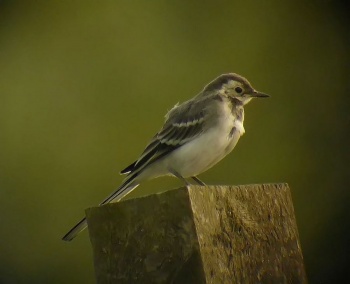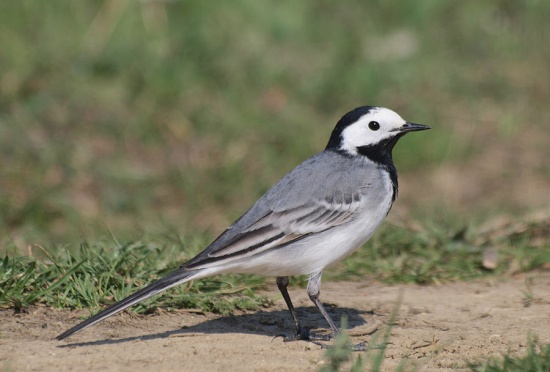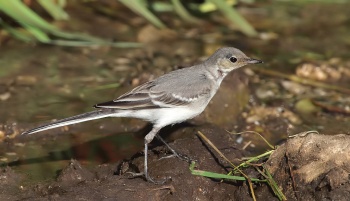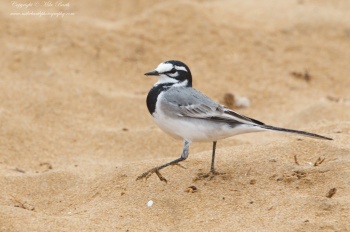- Motacilla alba
Includes: Pied Wagtail; Masked Wagtail; Black-backed Wagtail; Amur Wagtail; Himalayan Wagtail
Identification

Photo © by christineredgate
Haverigg, Cumbria, 16 January 2009
Length 16.5–18 cm (6-7 in), weight 17-25 g
Nominate subspecies in spring plumage is grey above with two white wingbars and white edgings to several feather tracts and white below (including relatively clean flanks), it has a white face, black cap and black throat; male has sharp demarkation of cap versus mantle, female diffuse.
In winter, the black in the throat area is reduced to a relatively narrow band, and the contrast on the upperside is reduced to the extent that the female may completely lack the black cap.
Juvenile plumage can be extremely weakly marked, but soon becomes first winter, which is similar to a less contrasting winter female; however, the head especially can look yellowish.
A thread discussing the separation of White and Pied Wagtails.
Variations
Variation among subspecies is large; for descriptive notes on other subspecies see the taxonomy section.

Photo © by cheersm8
Grazing Marsh, Cambridgeshire, UK, 3 July 2009
Distribution
Widespread and abundant from Iceland, northern Norway and Novaya Zemlya south to the north Mediterranean coast and northwest Africa, and east across northern and central Asia in Siberia, Japan, Korea, China and the Himalaya; also just into North America in western Alaska. In the Mediterranean breeds on Sicily and Crete, irregularly on Sardinia and Cyprus.
A summer visitor to the north and east of its range, resident elsewhere. Widespread throughout southern Europe and around the Mediterranean in winter with some migrants wintering in tropical Africa and Asia.
Vagrants recorded north to Bear Island, Jan Mayen and Svalbard and south to the Azores, Madeira and Cape Verde Islands, and in North America mostly on the west coast south to Baja California, but also in Michigan, Louisiana, Florida, and North and South Carolina.
Taxonomy
Subspecies
Ten subspecies are accepted Clements[1], and nine by IOC[2]:
- M. a. yarrellii - Pied Wagtail
- Ireland, Britain and locally adjacent coastal western Europe; mainly resident, some wintering south to Spain.
- Differs from M. a. alba in having black rather than grey back and dark dusky flanks; female have greyer back, but still clearly darker than M. a. alba; other plumages also similar to M. a. alba but with darker tones especially on back, flanks and rump. Sometimes split as a separate species[3].
- M. a. alba - White Wagtail
- Southeast Greenland, Iceland, the Faroe Islands, Scandinavia, and throughout continental Europe east to the Ural Mountains and the Caucasus; summer visitor in northern areas, resident further south; a common passage migrant and rare breeder in Britain, and vagrant in eastern USA. IOC includes M. a. dukhunensis and M. a. persica in M. a. alba as synonyms[2].
- M. a. dukhunensis
- Southern Russia and the Caucasus.
- Paler back than M. a. alba and broader white markings on greater coverts, but intergrades extensively.
- M. a. subpersonata - Moroccan White Wagtail
- M. a. personata - Masked Wagtail
- M. a. baicalensis
- South-central Siberia to northeast China.
- Similar to M. a. alba but males with extensive white on wing coverts forming a large white wing panel.
- M. a. ocularis
- Northern Siberia to northwest Alaska; winters southeast Asia; vagrant on the west coast of North America south to Baja California.
- Similar to M. a. alba but differs from it and M. a. baicalensis in fine black line through eye.
- M. a. lugens - Black-backed Wagtail
- Coastal southeast Siberia and islands, northern Korea and northern and central Japan; vagrant on the west coast of North America.
- Black above with extensive white on wing coverts and flight feathers forming a large white wing panel. Black line through eye similar to M. a. ocularis. Separated as a distinct species by the American Ornithologists' Union from 1982 until 2005, when lumped back into M. alba. Sometimes still treated as full species[4].
- M. a. leucopsis - Amur Wagtail
- M. a. alboides - Himalayan Wagtail
Habitat
Open areas with some vegetation from Arctic regions and high mountains to semi-deserts and sea-coasts. Usually beside freshwater including ditches, streams, rivers and from pools up to the largest lakes and reservoirs. Also occurs away from water on farmland, frequently in farmyards and in town parks and gardens. Often forms large roosts in winter.
Behaviour
Very active, running around on open ground to pick up insects; usually fairly noisy, calling frequently. Like all wagtails, wags tail up and down almost constantly. Sings from a conspicuous perch, such as roof or wall tops.
Flight
Markedly undulating flight.
Breeding
The nest is a grass cup in hole or crevice and can be found in a bank, cliff, woodpile or shed. The clutch consists of 5 or 6 whitish eggs speckled with grey. They are incubated for about 2 weeks and fledge a further 2 weeks later. There may be 2 or 3 broods in the season which runs from March to September.
Diet
Can be seen scuttling around after insects, larvae and other invertebrates; also takes human-provided food like breadcrumbs.
Vocalisation
Strong tchizick in flight
White Wagtail voice clip

Photo © by thebirdguy
Seoul, South Korea, 4 January 2017
Gallery
Click on photo for larger image
Subspecies lugens
Photo © by katastrofa
Yatsu-higata mudflats, Tokyo, Japan, 22 March 2018
References
- Clements, J. F., P. C. Rasmussen, T. S. Schulenberg, M. J. Iliff, T. A. Fredericks, J. A. Gerbracht, D. Lepage, A. Spencer, S. M. Billerman, B. L. Sullivan, and C. L. Wood. 2023. The eBird/Clements checklist of Birds of the World: v2023. Downloaded from https://www.birds.cornell.edu/clementschecklist/download/
- Gill, F & D Donsker (Eds). 2018. IOC World Bird List (v8.2). doi : 10.14344/IOC.ML.8.2. Available at http://www.worldbirdnames.org/
- van den Berg, A. (2016). Dutch Birding Checklist of Dutch bird species
- Sibley, DA. 2000. The Sibley Guide to Birds. New York: Alfred A. Knopf. ISBN 978-0679451228
- Adriaens, P., Bosman D. & Elst, J. (2010). White Wagtail and Pied Wagtail: a new look. Dutch Birding 32: 229-250.
- Alström, P. and K. Mild. 2003. Pipits and wagtails. Princeton: Princeton University Press.
- Badyaev, A. V., D. D. Gibson, B. Kessel, P. Pyle, and M. A. Patten (2017). White Wagtail (Motacilla alba), version 3.0. In The Birds of North America (P. G. #Rodewald, Editor). Cornell Lab of Ornithology, Ithaca, NY, USA. Retrieved from Birds of North America: https://birdsna.org/Species-Account/bna/species/whiwag
- Morlan, J. (1981). Status and identification of forms of White Wagtails in western North America. Continental Birdlife no. 2:37-50.
- Tyler, S. (2018). White Wagtail (Motacilla alba). In: del Hoyo, J., Elliott, A., Sargatal, J., Christie, D.A. & de Juana, E. (eds.). Handbook of the Birds of the World Alive. Lynx Edicions, Barcelona. (retrieved from https://www.hbw.com/node/57821 on 9 September 2018).
- Birdwatching Magazine
Recommended Citation
- BirdForum Opus contributors. (2025) White Wagtail. In: BirdForum, the forum for wild birds and birding. Retrieved 14 May 2025 from https://www.birdforum.net/opus/White_Wagtail
External Links
GSearch checked for 2020 platform.1











